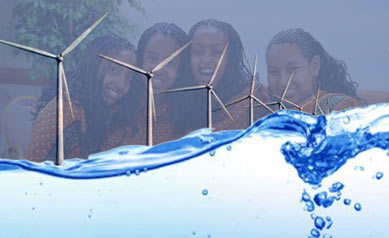Of Water, Women and Wind: The Three Ws of Eritrea

Semere Andom, the child of the Ontario water, wiring from Toronto–fresh is its breeze!
The Water
Isaias Afwerki told Eritreans that water does not come to where people are, it is the people who should travel to where it is available. He was predictably belligerent in the context of the question given his habitual disrespect of our people, but water for Eritreans is much more than its intrinsic usage and they have been travelling to where water is, both in their imagination and in their folklore. Water is irrevocably inscribed in our linguistic and cultural lexicons. Water for Eritreans is a slogan where they drive their pride and pedigree. Some of the water is fictitious, some even the size of a Jacuzzi. It does not matter. “Mai tray nibel!” Let’s just repeat, Water!
When my cousin who was born and spent her entire teenage years in Asmara said “gual mai tekhela” when she slipped on the wet kitchen floor, I laughed so hard that I smashed the plates I was carrying. The cousin in question by then has lived twenty five years in Italy. When I traveled to Eritrea after independence I asked my younger cousin to take me to “mai tekhela” for a swim, he looked at me in confusion and told me that there is no such thing as “Ruba mai tekhela”, everything is “mai tekhela”, even this, pointing to his “mlelikh” brimming with suwa, is “mai tekhela” he told me. I was not kidding with him, I thought that there was a river, a pond called “mai tekhela” somewhere around Mendefera. My laughter at my cousin was because she did not have any connection with that water which I believed actually existed. In the Sudan there was a guy who used to be a known “doshkka” gunner in the ELF and his nickname was wedi “mai guayla”. He was from Tsaazega. I am not sure if there is a river or a pond by that name, but his nephew who was from Asmara and a childhood friend would occasionally swear “wedi mai guayla” when kids bullied him.
Many songs in Tigrayit and Tigrnya mention water of something. Deqi Mai Adkemom, Gual Mai Dearit, and fetch me water from the Anseba River are the common ones, without mentioning the obscure waters.
Eritreans are fond of their waters in their songs and in their slogans. Not to be outdone, the Asmarinos, who do not identify with any particular region collectively have their La Fountain to call their own: “Mai Jah-Jah”. In high school a Kerenite friend of mine wrote a love letter to my Asmarino friend. Annoyed, she replied with one liner: “Gual Mai-Jah –Jah eko iye ‘ta”, to which he replied with one liner, “Wedi Mai Dearit ember iye ‘ti”.
The Women
Then there are the Eritrean women. Long before their participation with the often quoted 30%, the Eritrean women were invoked when men were challenged or they were daring, “hawwi ekelit” That tradition is almost gone now. There was an Eritrean business man in the Sudan in the late eighties, who would chant “Ane Wedi Silas” when he gets angry or something happened to him. I was curious, but with a cursory inquiry to people around him I learned that his mother was a very strong woman in their village somewhere in Hamssien. She would milk cows, which is unheard of in the customs of that part of Eritrea. She would harness the oxen and plough the land, she would dare the men in “Baitto”. So I was told that like Rasi Woldemichael Solomon, who went by Wedi-Elleni, this Eritrean proudly invokes his mother’s strength.
This is mostly in the highlands of Eritrea. The lowlands, in the Tigre the invocation of woman is not limited to one’s sister or mother. When I was living in the Sudan, an Eritrean youth whose uncle owned the restaurant we frequented arrived from Barka and started working there. He was a nice young man and he treated us well. My friends and I befriended him and tutored him in English as he was very late in his schooling. But if a cup is broken, or he hears a loud cacophony of dishes or a bang on a table he would always say, Aderot. Everything is Aderot, he slips, it is Aderot, someone arm wrestles him, Aderot was his trash talk. He gets the English word wrong, it is something, something Aderot. So I thought it was the equivalent of the Tigrinya “wedaEte”, but one day I noticed one difference, when you say “wedaEte”, no one said anything, but whenever our friend said Aderot someone, mostly a Tigrayit speaker would say something to him. Much later he left to Jizan and we missed him. One day someone spilled my tea and I spontaneously said Aderot, but no one said anything to me, even those who used to say that something to him. Then I learned two things: Aderot was not the equivalent of “wedaEte”, rather, it was the name of a beauty in his village. I was told she was tall like an arkokobay tree, her braided hair covered her lower back, her piercing darks eyes intimated everyone when she rolled them and her white teeth illuminated the darkest room when she smiled. She was not a fictitious or mystical figure. She lived and breathed, danced, sang and wed and bred. I wanted to learn more so I asked about the other thing they said to him whenever he mentioned Aderot. It was “semmekka allet” (she was also talking about you).
The Wind
Every Eritrean brags about his city, his region or village, how its cappuccino or its ice-scream tests better or how the potatoes that grow in the fertile soil of his village are the best, oh, yea, the potatoes of “Karneshim”! The Tigre Eritreans would also brag about their region just like the rest but they take it to the next level. They would speak of theirs as Keren “brud shemalla” or Aderde “brud shemalla”. Keren, its wind/breeze is fresh/cool.
Until I heard a guy from Agordat say Agordet “brud shemalla” with nostalgia, I believed that the weather in their villages was cool. But it turns out that “fresh is its breeze” is a fiction like my cousin’s “mai Tekhela”. What I remember about Agordat is fainting of heatstroke and when I told our friend from Agordat that there is not even oxygen in Agordat let alone fresh breeze and wind, he replied that I do not have a clue about Agordet “brud shemalla”.
Conclusion
In almost every Tigrayit love song, the woman is tall like arkokobay or camel, every young and beautiful girl is “tithawarir wo titlewale”: She rolls her eyes, and her body is flexible. Dah, of course she is going to roll her eyes and she is flexible, she is young. That beautiful girl also drinks from Mai Dearit, and she smells of Sandal and of ginger.
In almost every Tigriniya love song, the beautiful girl is as tall as Segen, she is as slim and willowy as the Syye Tree and she is from Embasoira or she is from the La Fountana in Geza Banda. This beauty is also “ayna fenagil, selemlem teblo”, her espresso coffee mug sized eyes are flirtatious. The young beauty is also almost always told not to mind the gossip of the village. And every beautiful girl drinks from some water in Eritrea, some fictitious some real. She also smell of Shillan plant and Mommona tree.
Do not we love our Water, Women and Wind! Who doesn’t. These are the goodness of life, but it is time for our artists to unleash their creativity when describing the “WWW” of Eritrea.



Awate Forum